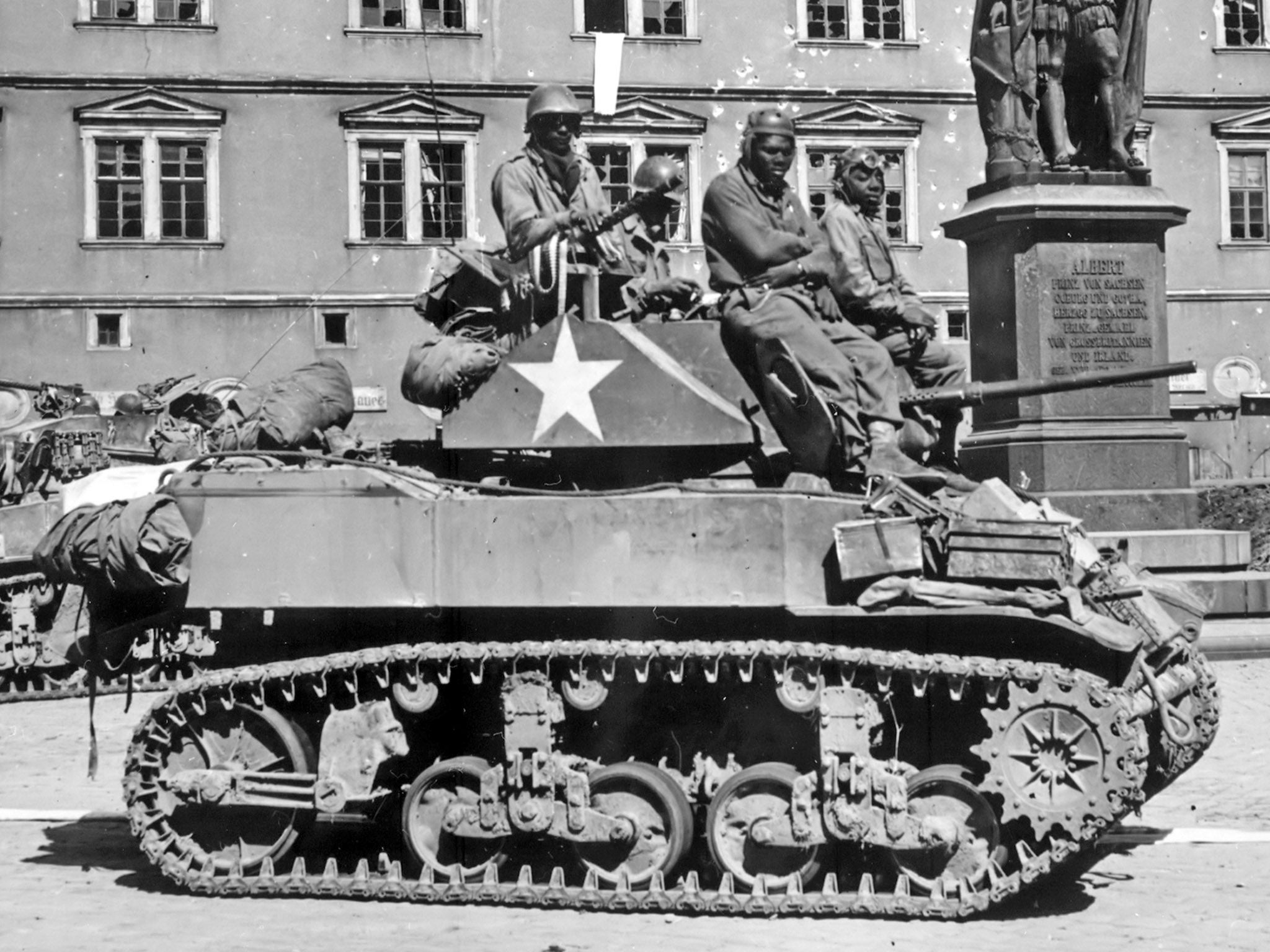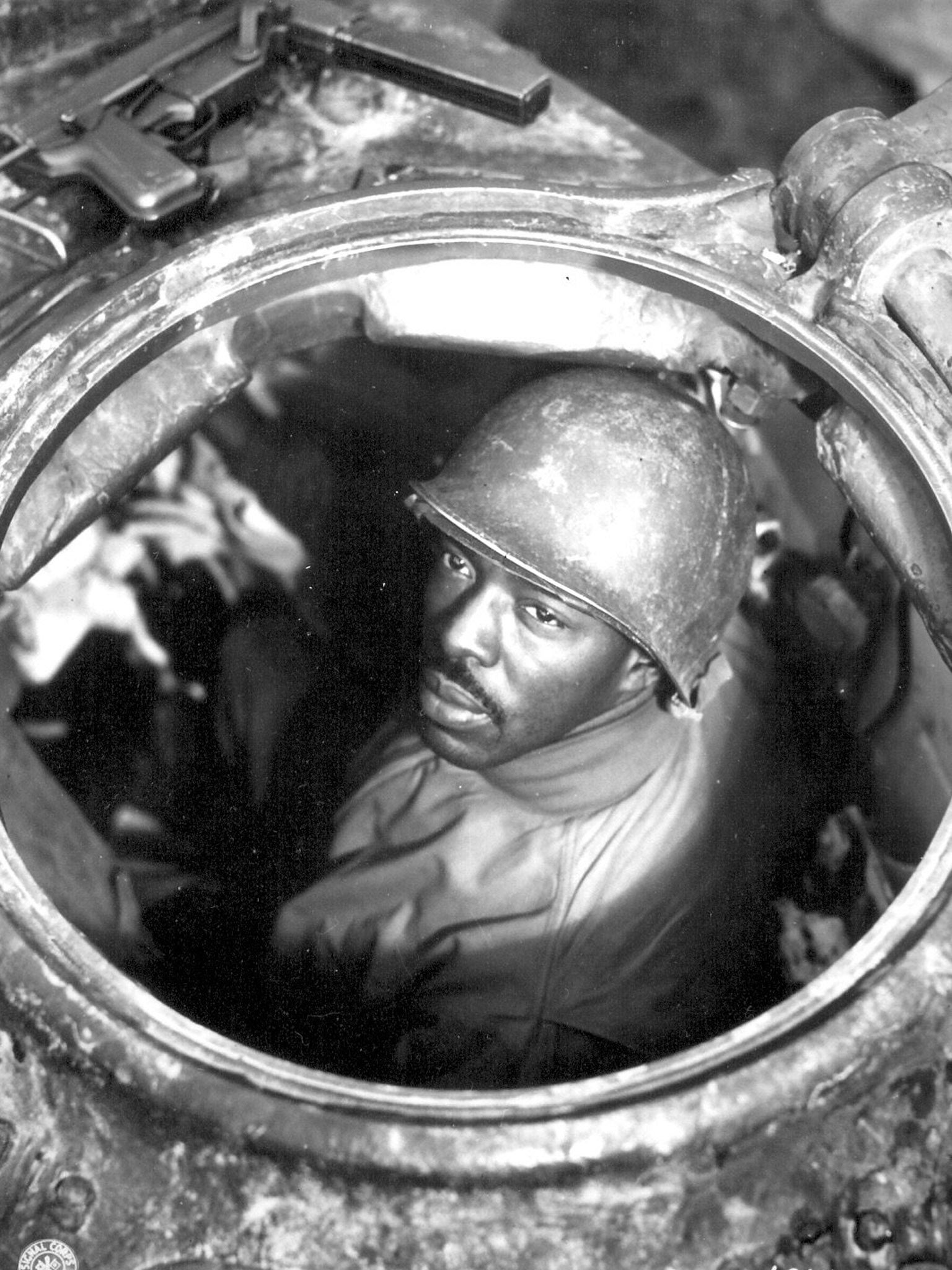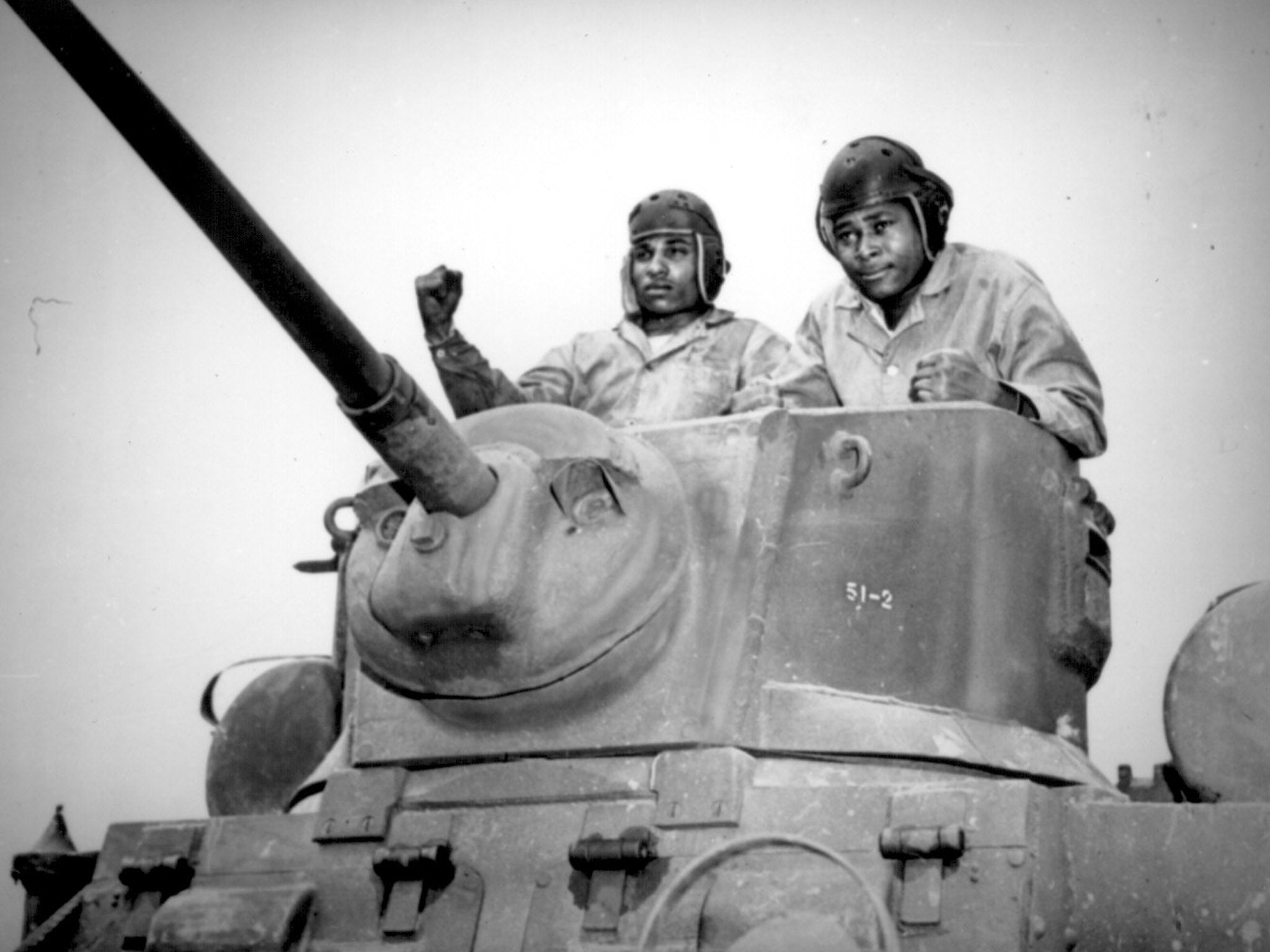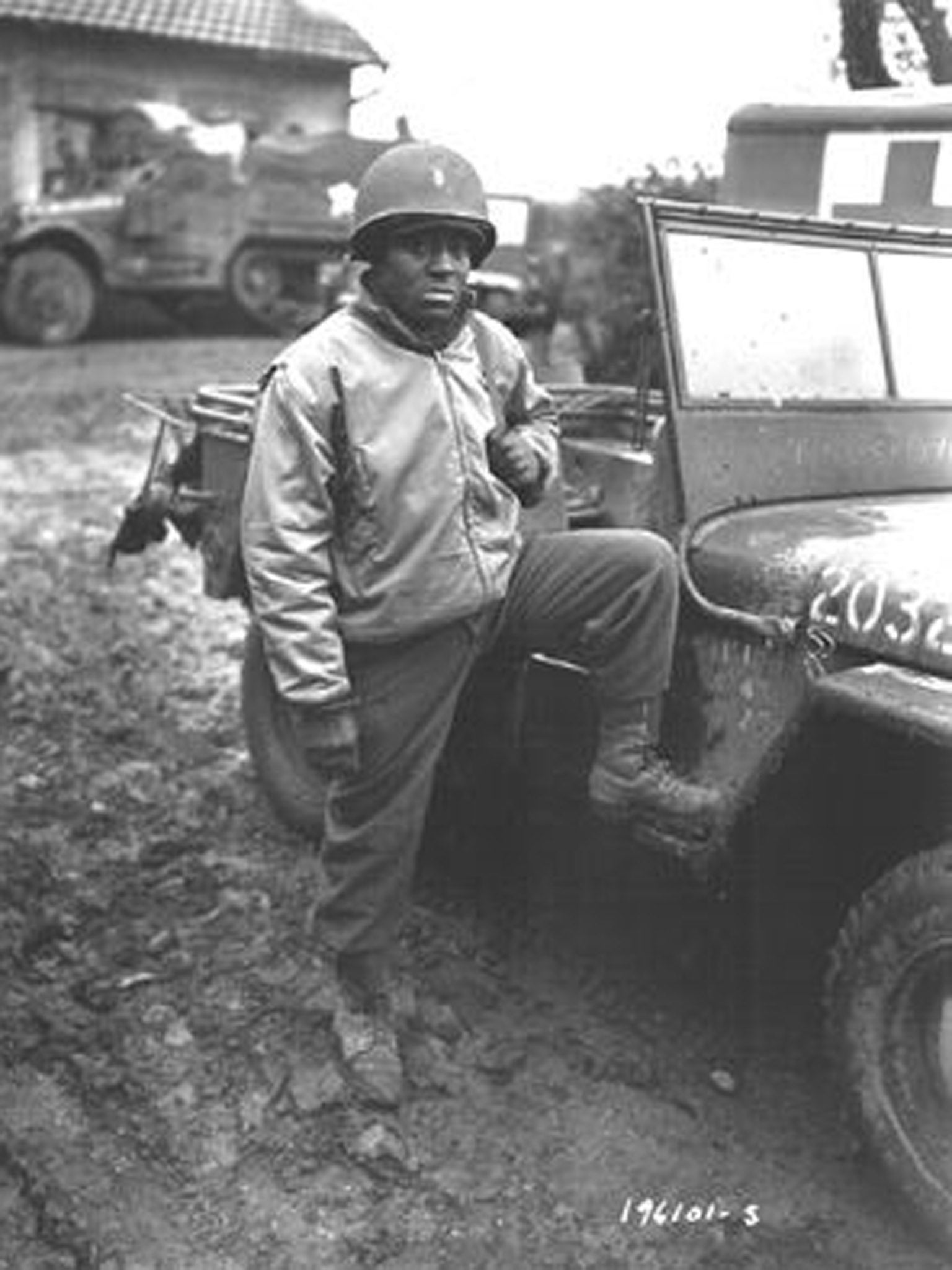The real Black Panthers: The soldiers who came out fighting against the Nazis and the race prejudice of white America
The courage and professionalism of the first African-American armoured unit to enter combat paved the way for the ending of racial segregation in the US military. Now their exploits are to be turned into a film produced by ‘Black Panther’ star Michael B Jordan

As they lumbered towards the French town of Morville-lès-Vic, their dark tanks stood out like sore thumbs against the background of freshly fallen snow.
To the waiting, battle-hardened Germans these Americans – freshly arrived in France, untested in combat – might have seemed like lambs to the slaughter.
The 761st Tank Battalion, the “Black Panthers”, were about to become the first African-American armoured unit to enter combat.
And in his Sherman tank, B Company commander Capt John D Long, a young black man from Detroit, Michigan, knew what he was fighting for.
“Not for God and country,” he said later, “But for me and my people.
“I expected to get killed, but I swore to myself there would never be a headline saying my men and I chickened.”
Now, though, he and his men were about to discover what it was like to face the fanaticism of the Second World War German army, and to come up against elements from two SS Panzer Divisions.
“Morville-lès-Vic was supposed to be a snap,” Long told the authors of the book The Invisible Soldier. “But it was an inferno.”
When B Company forced its way into the town on the morning of 9 November 1944, it met a hail of machine gun and anti-tank fire coming from the windows and cellars of the houses, from all directions.
At a crucial intersection, the tank commanded by Sgt Roy King took a direct hit from a panzerfaust. King was shot dead as he exited the blazing tank and two other crew members were wounded.
The situation was now desperate. Without the tank’s firepower, the supporting infantry were being pinned down and picked off by the Germans. Some 15 American soldiers were now lying dead or wounded in the street.
But the two tank crew members who had escaped uninjured were, like their company commander, in no mood to chicken out.
Private John McNeil grabbed his sub-machine gun and used it to keep the Germans at bay while Technician James T Whitby re-entered the burning tank via the escape hatch. He started firing the 30-calibre machine gun.
McNeill kept firing from under the Sherman. The tank was hit two more times. McNeill and Whitby stayed where they were. They kept firing for three hours, taking out enemy machine gun nests and a panzerfaust team that was trying to fire from an upstairs window.
And so the advance continued and when, after another day’s vicious fighting, the battle was over, a captured German remembered the men who had kept firing from the burning tank.
“Such bravery,” he said, “I have seen but once before, and that was on the Russian front.”
One officer and nine enlisted men of the Black Panthers lay dead. Another 20 men of the 761st were wounded.
“We got our lumps,” recalled Long, “But we took that f***ing town.”

Before becoming one of the first two black first lieutenants in the US tank corps, Long had been a cook at Fort Knox, Kentucky – because the pre-war US Army thought “the Negro” was only good for menial labour.
Now Long was on his way to earning the nickname “The Black Patton”, and the men of the 761st were proving that in modern, mechanised warfare the “Negro” was every bit the equal of the white man.
“After Morville-lès-Vic”, said Long, “there wasn’t a white outfit that wasn’t damned glad to have us. We were fighting sons-of-bitches, and our reputation came before us.”
If it sounds like the stuff of movies, that’s because it soon will be. Fresh from starring in Black Panther, the first blockbuster superhero film with a mostly black cast, Michael B Jordan is reportedly planning to produce a film about the other black panthers of the 761st.
Competition for the script deal was said to have been intense, with Warner Bros finally emerging victorious.
If such mainstream appeal may seem obvious today, the question might also have to be asked: why were the men of the 761st so seemingly invisible for so long?
It is not as if their achievements stopped at Morville-lès-Vic.
By the end of the war in Europe, the Black Panthers had fought their way further east than nearly every other American unit.
They had played a key role in the Battle of the Bulge and in the crossing of the Rhine. They had inflicted more than 130,000 casualties on the enemy, received 391 decorations for heroism, and liberated Gunskirchen, a sub-camp of Mauthausen concentration camp.
And yet when Staff Sgt Johnnie Stevens got his honourable discharge from the army and tried to board the bus from Fort Benning, Georgia, on his way home to New Jersey, the driver refused to let him on, and called him “boy” as he did so.
Stevens was at least lucky that he was waiting to board the bus with members of the 26th Infantry Division, which had provided the foot soldiers in the battle for Morville-lès-Vic. An enraged white sergeant swiftly ensured Stevens was on the bus, and riding up front.
But the disappointment must have been crushing. This wasn’t the first incident involving a white bus driver and a Black Panther.
In July 1944 Jackie Robinson, later to become the first black man to play Major League Baseball, had been a popular first lieutenant. But while on leave from training at Camp Hood, Texas, he had refused to move to the back of a bus when told to do so by a white civilian driver.
After the military police were called, Robinson ended up facing court martial charges that included public drunkenness – even though he didn’t drink.
Lt Col Paul L Bates, the white commanding officer of the 761st, refused to authorise the proceedings – so top brass transferred Robinson to another unit whose CO would consent to a court martial. Robinson was acquitted, but he missed his chance to serve in Europe with the Black Panthers.
The war, they had been promised, would change all this.

In June 1942, under the headline “All they want now is a fair chance to fight”, Life magazine had reported on the first black soldiers training for tank warfare.
“It is perfectly true,” the report acknowledged, “that US Negroes have never had a square deal from the US white majority, but now, when their country needs them, they are glad to work and fight and die alongside their white fellow citizens.
“That is the spirit which will some day wipe every trace of racial bigotry off the map of America.”
But when he returned from the fighting and dying, Johnnie Stevens found some things hadn’t changed.
In the years that followed, especially as they watched the civil rights struggle of the 1960s generation, the men of the 761st could have been forgiven for wondering exactly what had changed.
The fighting professionalism of these men, who deployed to France with just six white officers and who got their first black CO in 1945, did help give President Harry Truman the justification he needed to end segregation in the US military in 1948.
But for the 761st itself, no presidential unit citation was forthcoming until 1978 when, 33 years after the war ended, President Jimmy Carter belatedly recognised the Black Panthers’ contribution to winning it.
It is hard indeed to see why it took so long.
Between late 1944 and May 1945, the Black Panthers, with the motto “Come out fighting”, were engaged in 183 days of continual combat.
During the Battle of the Bulge, as the Nazis tried their last desperate offensive on the Western Front, the 761st was thrown against the crack troops of the 13th SS Panzer Division.
Five days of bitter fighting in freezing cold were summed up by the message of staff Sgt Frank Cochrane, who radioed from inside a tank facing withering German fire.
“They’ve hit me three times,” said Cochrane, “But I’m still giving ’em hell!”
On 9 January 1945, it was the SS who retreated from the Black Panthers, abandoning the road that had been the main supply route for the German forces besieging the 101st Airborne Division at Bastogne.
The 761st rolled on.

In March 1945 they played a key role in punching a hole in the Siegfried Line and getting the Allies across the Rhine. Operating well beyond the range of friendly artillery support, they attacked the enemy where his defences were strongest, facing elements of 14 German divisions and inflicting 4,100 casualties.
“The accomplishments of the 761st,” said Carter’s presidential citation, “were truly magnificent, as the successful crossing of the Rhine River into Germany was totally dependent upon the accomplishment of their mission.”
Two months later the Black Panthers liberated the skeletal inmates of Gunskirchen and watched them throw themselves on the raw meat of a horse that had just been killed by shellfire. After that, Long recalled, “Jerry was no longer an impersonal foe”.
By the time they linked up with the Soviet troops of the First Ukrainian Army on the banks of the Enn River in Steyr, Austria, they had fought through six European countries, displaying, in the words of the Presidental Citation, “indomitable fighting spirit and devotion to duty”.
But it wasn’t just the Presidential Citation that was late in coming. For some individual soldiers of the 761st, proper recognition had to wait until the Clinton presidency, not the Carter era.
That was more than 50 years after Staff Sgt Ruben Rivers performed his heroics in France.
As A Company advanced on 16 November 1944, Rivers’s tank was hit by a mine. Shrapnel had cut his leg from knee to thigh and as deep as the bone.
Capt David J Williams, his company commander, told him: “Ruben, you’ve got a million-dollar wound. You’re going home.”
“Captain,” Rivers replied. “You’re going to need me.”
Williams would later recall giving his sergeant a direct order to return to the rear.
Pushing away the morphine needle, refusing the stretcher, Rivers told his CO “This is the one order – the only order – I’ll ever disobey.”
Rivers, who had already won the battalion’s first Silver Star in the advance towards Morville-lès-Vic, got into another tank and carried on.
By 19 November the wound had become infected and he was in great pain. Again he refused to leave the field. As A Company advanced on the town of Bourgaltroff, Rivers’s tank was towards the front.
Suddenly they came under murderous fire from a group of German Jagdtigers, “hunting tiger” tank destroyers.
Two American tanks were knocked out almost instantly.
“Pull back, Panthers!” ordered Williams.
Rivers radioed his reply: “I see ’em. We’ll fight ’em.”
Alongside the tank commanded by Sgt Walter James, Rivers charged towards the enemy, all guns blazing.
“For a few minutes,” wrote the military historian Charles W Sasser, “The American Shermans held their own. Outnumbered and outgunned, they seemed to exist in a charmed atmosphere as brilliant tracers of green bounced off their thick hides.
“Then a high-explosive shell caught Rivers’ tank and cracked it like an egg. A second shell finished the job.”
Eleven months after he had joined the army, ignoring neighbours in Holtaka, Oklahoma, who told him it was a white man’s war, Rivers was dead at the age of 26.
But the charge which had killed him and wounded his crew had allowed the rest of the company to escape the tank destroyers.
Capt Williams immediately recommended Rivers for America’s highest military award, the medal of honour.
But Rivers was overlooked. So were others. In fact, during the Second World War, no African-American soldier received the medal of honour.
Only in 1993 did the US army accept that there had been “a racial disparity in the way medal of honour recipients were selected”.
Finally, on 13 January 1997 President Bill Clinton presented the medal of honour to one surviving veteran and to the families of six men who had passed away.
Grace Woodfork, one of Rivers’s sisters, received the medal on her late brother’s behalf. The elderly Capt Williams was with her.
By then, Grace was no longer just a soldier’s sister. She had grown up to become a community activist, and the mother of George Livingston, the first black mayor of Richmond, California.
George was ten when he heard Uncle Ruben had died.
“I cried for days,” he said in 1995. “There are those living the good life now because of them giving their lives.”
If today some fear America is regressing in its race relations, a forthcoming film celebrating Ruben Rivers and all who came out fighting with the Black Panthers may serve as a reminder that the country also has men and women with the guts to change it for the better.
Join our commenting forum
Join thought-provoking conversations, follow other Independent readers and see their replies
Comments